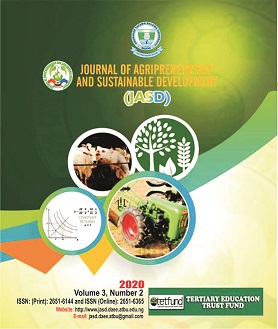STRUCTURAL ANALYSIS OF FISH MARKETING IN TARABA STATE, NIGERIA
DOI:
https://doi.org/10.59331/jasd.v3i2.115Keywords:
Fish marketing, Gini co-efficient, Hypothesis, Market structure and QuestionnairesAbstract
The study analyzed the structure of fish marketing in Taraba State, Nigeria. Multi-stage sampling technique consisting of purposive and random sampling was used in selecting 188 respondents. Data were collected with the aid of structured. Frequency tables, percentage, gini coefficient were used to describe and analyze data. T-test was used to test the null hypothesis. Majority (62.2%) of the respondents were retailers while 37.8% were wholesalers. Respondents who sourced their initial capital for the business from their own savings made up 43.9%. About 53.3% were members of cooperatives, 87.8% were non-seasonal traders and 94.4% of the respondents set their price through haggling. Gini coefficient of 0.59 was found amongst the retailers indicating a moderately concentrated market while the wholesalers had a gini coefficient of 0.47 indicating that the market was not concentrated. Fish marketing was tested to be profitable at 5% level of significance. The major constraints associated with fish marketing in the study area were insufficient capital questionnaires, insecurity challenges, among others. Based on these findings, this study recommends that marketers should be effectively linked to available financial institutions so as to obtain soft loans. They should also collaborate with the vigilante group to combat some of the insecurity problems associated with theft.
Downloads

Downloads
Published
How to Cite
Issue
Section
License
Copyright (c) 2022 Journal of Agripreneurship and Sustainable Development

This work is licensed under a Creative Commons Attribution 4.0 International License.






